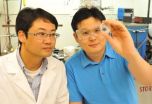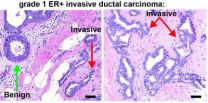(Press-News.org) PULLMAN, Wash.–Washington State University researchers have developed the first fuel cell that can directly convert fuels, such as jet fuel or gasoline, to electricity, providing a dramatically more energy-efficient way to create electric power for planes or cars.
Led by Professors Su Ha and M. Grant Norton in the Voiland College of Engineering and Architecture, the researchers have published the results of their work in the May edition of Energy Technology. A second paper on using their fuel cell with gasoline has been accepted for publication in the Journal of Power Sources. The researchers have made coin-sized fuel cells to prove the concept and plan to scale it up.
About 10 years ago, the researchers began developing a solid-oxide fuel cell to provide electrical power on commercial airplanes. Fuel cells offer a clean and highly efficient way to convert the chemical energy in fuels into electrical energy. In addition to increasing fuel efficiency and reducing emissions of harmful pollutants, fuel cells are quiet and would be particularly helpful when a plane is at a gate and the main jet engines are turned off.
A solid-oxide fuel cell is similar to a battery in that it has an anode, cathode, and electrolyte and creates electricity. But it uses fuel to create a continuous flow of electricity. The process could be approximately four times more efficient than a combustion engine because it is based on an electrochemical reaction. The solid-oxide fuel cell is different from other fuels cells in that it is made of solid materials, and the electricity is created by oxygen ions traveling through the fuel cell.
Using jet fuel and gasoline to power their fuel cell proved tricky. To avoid the added weight of a device that converts the complex fuel into simpler components, such as hydrogen and carbon monoxide (a mixture called synthesis gas) the researchers wanted to be able to directly feed the liquid fuel into the fuel cell. Furthermore, they had to overcome the problems of sulfur poisoning and coking, a process in which a solid product is created from imperfect combustion. Sulfur is present in all fossil-based fuels and can quickly deactivate fuel cells.
Using a unique catalyst material and a novel processing technique, Ha and Norton and collaborators at Kyung Hee University in South Korea and the Boeing Company in Seattle have produced a high-performance fuel cell that operates when directly fed with a jet fuel surrogate.
"The results of this research are a key step in the integration of fuel cell technology in aviation and the development of the more electric airplane," said Joe Breit, associate technical fellow at Boeing and a participating researcher on the project.
The researchers envision integrating their fuel cell with a battery to power auxiliary power units. These units are currently powered by gas turbines and operate lights, navigation systems and various other electrical systems. The two technologies complement each other's weaknesses, says Ha.
The researchers also have used gasoline to power their fuel cell and envision someday using it to power cars. Vehicles powered in this way could use existing gas stations, rather than having to develop a hydrogen-based infrastructure.
INFORMATION:
WSU researchers develop fuel cells for increased airplane efficiency
First cell to directly convert jet fuel and gasoline to electricity
2014-06-16
ELSE PRESS RELEASES FROM THIS DATE:
Sleep quality and duration improve cognition in aging populations
2014-06-16
EUGENE, Ore. -- (June 16, 2014) -- Maybe turning to sleep gadgets -- wristbands, sound therapy and sleep-monitoring smartphone apps -- is a good idea. A new University of Oregon-led study of middle-aged or older people who get six to nine hours of sleep a night think better than those sleeping fewer or more hours.
The study, published in the June issue of the Journal of Clinical Sleep Medicine, reaffirms numerous small-scale studies in the United States, Western Europe and Japan, but it does so using data compiled across six middle-income nations and involving more than ...
Tugging on the 'malignant' switch
2014-06-16
Cambridge, Mass. – June 16, 2014 – A team of researchers led by David J. Mooney, Robert P. Pinkas Family Professor of Bioengineering at the Harvard School of Engineering and Applied Sciences, have identified a possible mechanism by which normal cells turn malignant in mammary epithelial tissues, the tissues frequently involved in breast cancer.
Dense mammary tissue has long been recognized as a strong indicator of risk for breast cancer. This is why regular breast examinations are considered essential to early detection. Until now, however, the significance of that tissue ...
Sensor in eye could track pressure changes, monitor for glaucoma
2014-06-16
Your eye could someday house its own high-tech information center, tracking important changes and letting you know when it's time to see an eye doctor.
University of Washington engineers have designed a low-power sensor that could be placed permanently in a person's eye to track hard-to-measure changes in eye pressure. The sensor would be embedded with an artificial lens during cataract surgery and would detect pressure changes instantaneously, then transmit the data wirelessly using radio frequency waves.
The researchers recently published their results in the Journal ...
LLNL researchers develop high-quality 3-D metal parts using additive manufacturing
2014-06-16
LIVERMORE, Calif. – Lawrence Livermore National Laboratory researchers have developed a new and more efficient approach to a challenging problem in additive manufacturing -- using selective laser melting, namely, the selection of appropriate process parameters that result in parts with desired properties.
Selective laser melting (SLM) is a powder-based, additive manufacturing process where a 3D part is produced, layer by layer, using a high-energy laser beam to fuse the metal powder particles. Some SLM applications require parts that are very dense, with less than ...
Embryonic stem cells offer new treatment for multiple sclerosis
2014-06-16
Scientists in the University of Connecticut's Technology Incubation Program have identified a novel approach to treating multiple sclerosis (MS) using human embryonic stem cells, offering a promising new therapy for more than 2.3 million people suffering from the debilitating disease.
The researchers demonstrated that the embryonic stem cell therapy significantly reduced MS disease severity in animal models and offered better treatment results than stem cells derived from human adult bone marrow.
The study was led by ImStem Biotechnology Inc. of Farmington, Conn., ...
Antarctic species dwindle as icebergs batter shores year-round
2014-06-16
The Antarctic shore is a place of huge contrasts, as quiet, dark, and frozen winters give way to bright, clear waters, thick with algae and peppered with drifting icebergs in summer. But as the planet has warmed in the last two decades, massive losses of sea ice in winter have left icebergs free to roam for most of the year. As a result, say researchers reporting in the Cell Press journal Current Biology on June 16, boulders on the shallow seabed—once encrusted with a rich assemblage of species in intense competition for limited space—now mostly support a single species. ...
First Canadian Bell palsy guideline
2014-06-16
The first Canadian guideline for Bell palsy, facial weakness or paralysis caused by facial nerve damage, is aimed at helping physicians manage and treat patients during the acute phase as well as recovery. The guideline, published in CMAJ (Canadian Medical Association Journal), is based on the growing body of recent evidence on the condition.
Bell palsy is damage to the facial nerve that results in sudden weakness or paralysis of one side of the face. It can come on suddenly with symptoms such as drooping of the face and eyelids, twitching, and others that may include ...
A faster path to optical circuits
2014-06-16
Just as electronic circuits work with electrical charges, optical circuits process pulses of light, which gives them a distinct advantage in terms of speed. Optical technologies are therefore the object of intense research, aiming to develop novel optical devices that can control the flow of light at the nanometer scale. EPFL scientists have developed a new method that can optimally design a widely-used class of optical devices with unprecedented effectiveness. Their designs have been fabricated in the US, at the University of Rochester, and successfully tested in Italy, ...
Discovery of a bud-break gene could lead to trees adapted for a changing climate
2014-06-16
CORVALLIS, Ore. — Scientists have confirmed the function of a gene that controls the awakening of trees from winter dormancy, a critical factor in their ability to adjust to environmental changes associated with climate change.
While other researchers have identified genes involved in producing the first green leaves of spring, the discovery of a master regulator in poplar trees (Populus species) could eventually lead to breeding plants that are better adapted for warmer climates.
The results of the study that began more than a decade ago at Oregon State University ...
Study shows chikungunya mutation places several countries at risk of epidemic
2014-06-16
GALVESTON, Texas — For the first time, University of Texas Medical Branch at Galveston researchers were able to predict further adaptations of the chikungunya virus that recently spread from Africa to several continents that will likely result in even more efficient transmission and infection of more people by this virus strain.
A key factor in a viruses' potential to sustain its circulation and ultimately cause disease is its ability to adapt to new host environments. The number and complexity of these adaptations is shaped by how hospitable the new host is to a certain ...
LAST 30 PRESS RELEASES:
Hospitals acquired by real estate investment trusts associated with greater risk of bankruptcy, closure
City of Hope scientists study rare disorder to uncover mechanism and hormone regulation underlying fatty liver disease and sweet aversion
Your genes may influence gut microbiome of others, rat study shows
‘Personality test’ shows how AI chatbots mimic human traits – and how they can be manipulated
Global food systems driving twin crises of obesity and global heating
Osaka Medical and Pharmaceutical University researchers capture real-time molecular movies of enzyme catalysis
Could your genes influence the gut microbiome of others?
Clues to Alzheimer’s disease may be hiding in our ‘junk’ DNA
Study reveals that the body uses different sensors to detect cold in the skin and in internal organs
iPS cells from dish to freezer and back
Deep neural networks enable accurate pricing of American options under stochastic volatility
Collective risk resonance in Chinese stock sectors uncovered through higher-order network analysis
Does CPU impact systemic risk contributions of Chinese sectors? Evidence from mixed frequency methods with asymmetric tail long memory
General intelligence framework to predict virus adaptation based on a genome language model
Antibiotic resistance is ancient, ecological, and deeply connected to human activity, new review shows
Vapes, pouches, heated tobacco, shisha, cigarettes: nicotine in all forms is toxic to the heart and blood vessels
From powder to planet: University of Modena engineers forge a low-carbon future for advanced metal manufacturing
Super strain-resistant superconductors
Pre-school health programme does not improve children’s diet or physical activity, prompting call for policy changes, study finds
Autumn clock change linked to reduction in certain health conditions
AI images of doctors can exaggerate and reinforce existing stereotypes
Where medicine meets melody – how lullabies help babies and parents in intensive care
We may never be able to tell if AI becomes conscious, argues philosopher
AI video translation shows promise but humans still hold the edge
Deep ocean earthquakes drive Southern Ocean’s massive phytoplankton blooms, study finds
Without campus leftovers to pick through, the beaks of this bird changed shape during the pandemic
High-dose antibiotic does not reduce mortality in tuberculous meningitis
How many insects fly in the sky above the USA?
Could cheese protect your brain health?
Who faces more difficulty recovering from stroke?
[Press-News.org] WSU researchers develop fuel cells for increased airplane efficiencyFirst cell to directly convert jet fuel and gasoline to electricity





